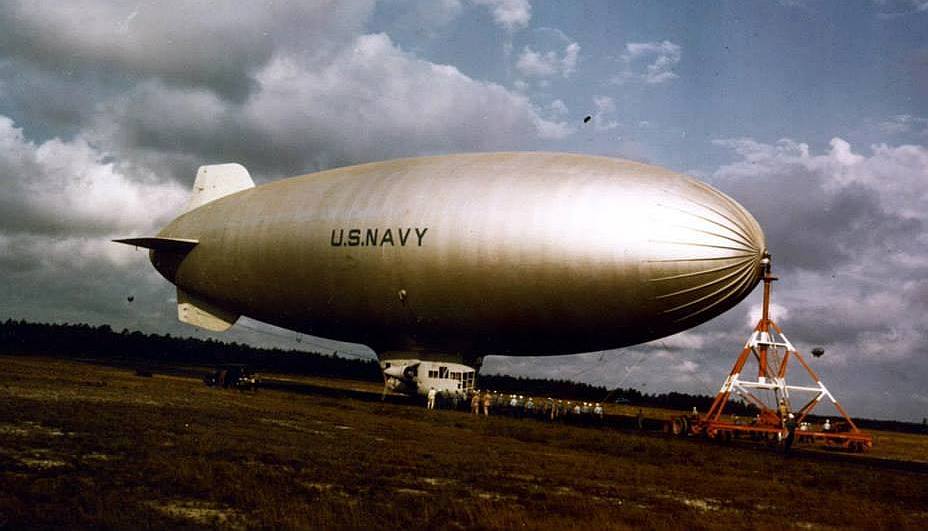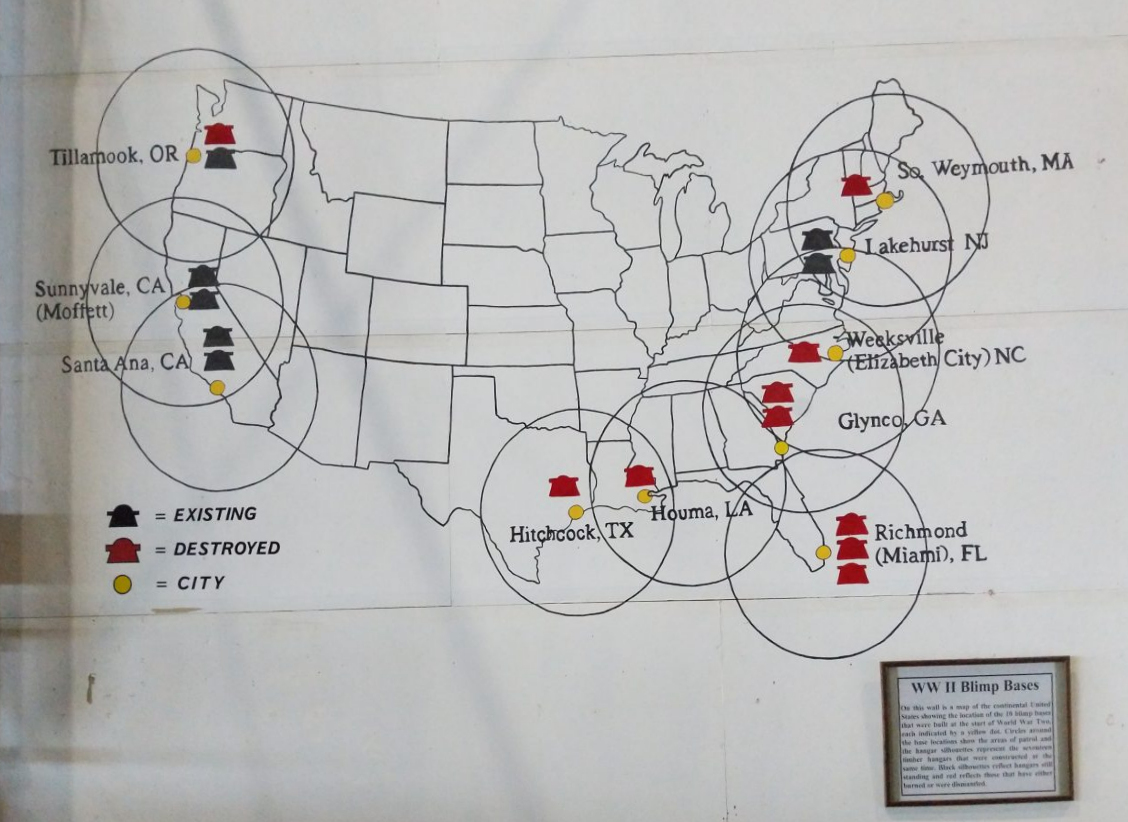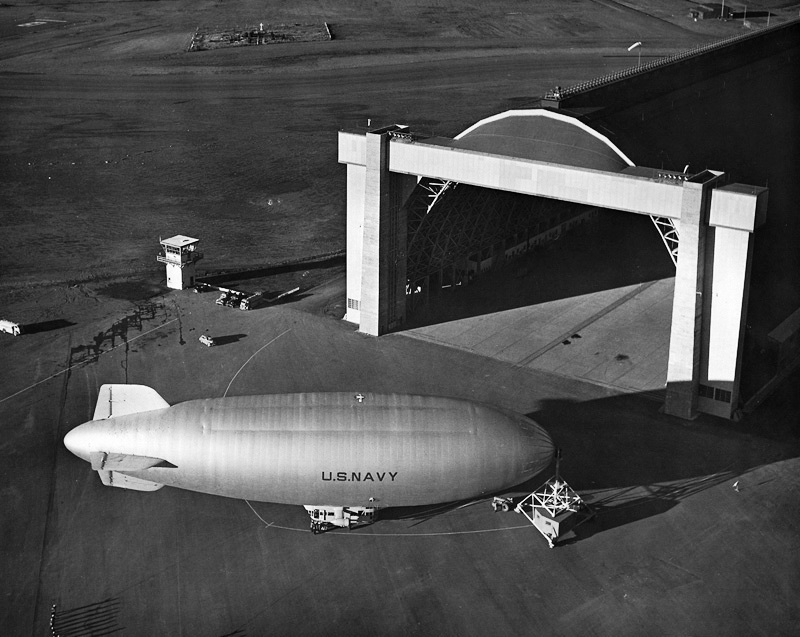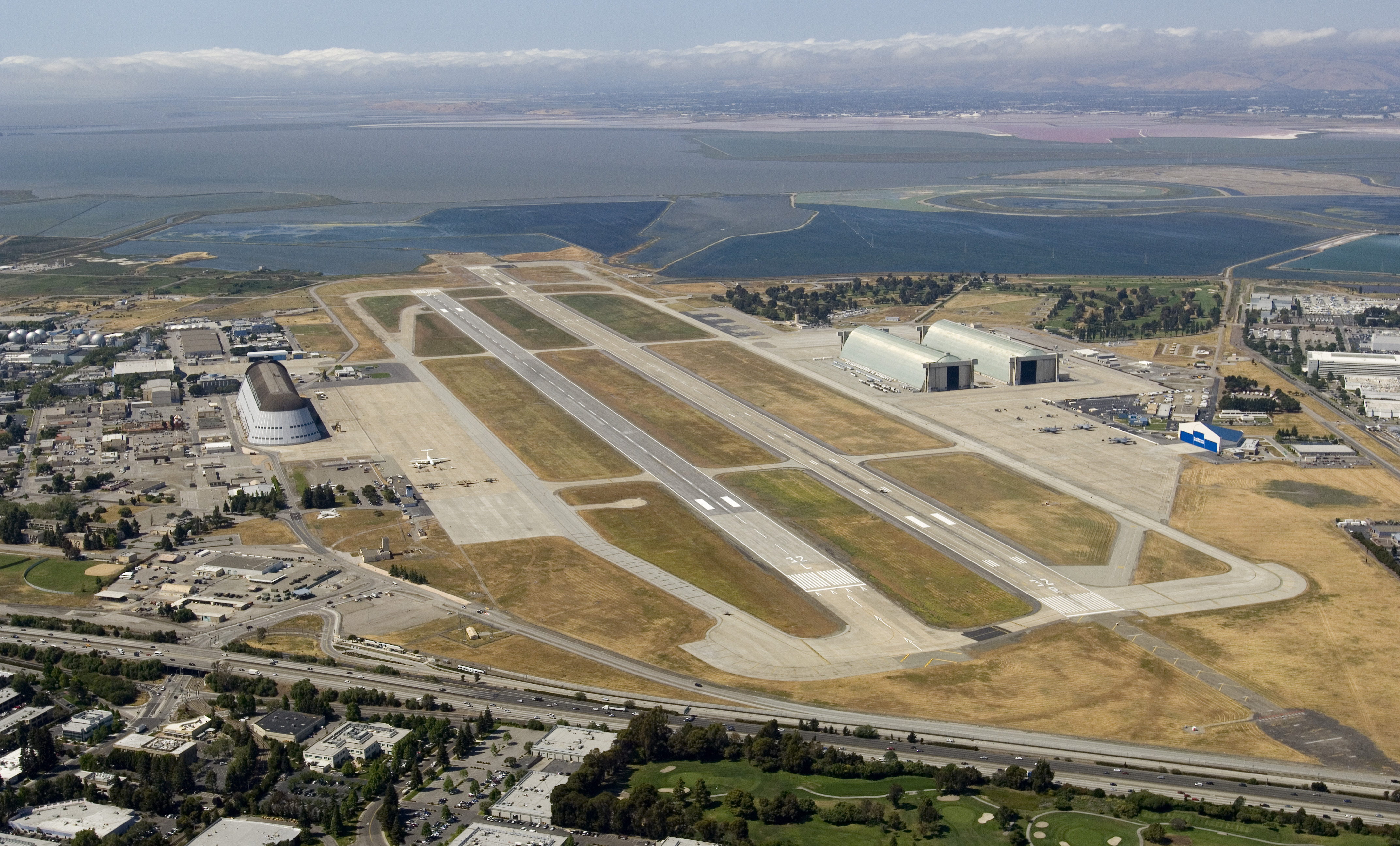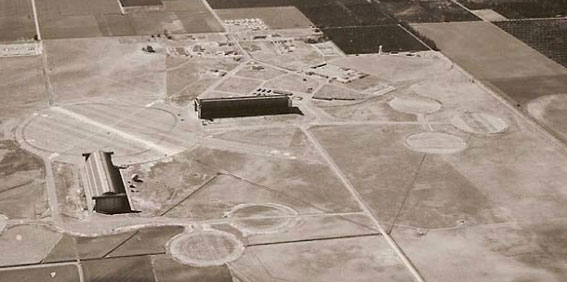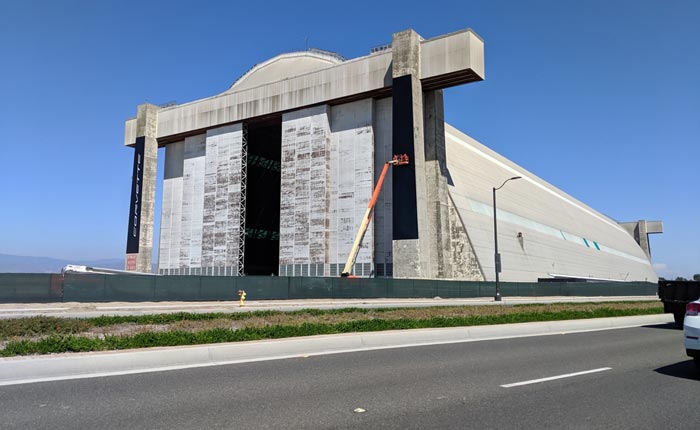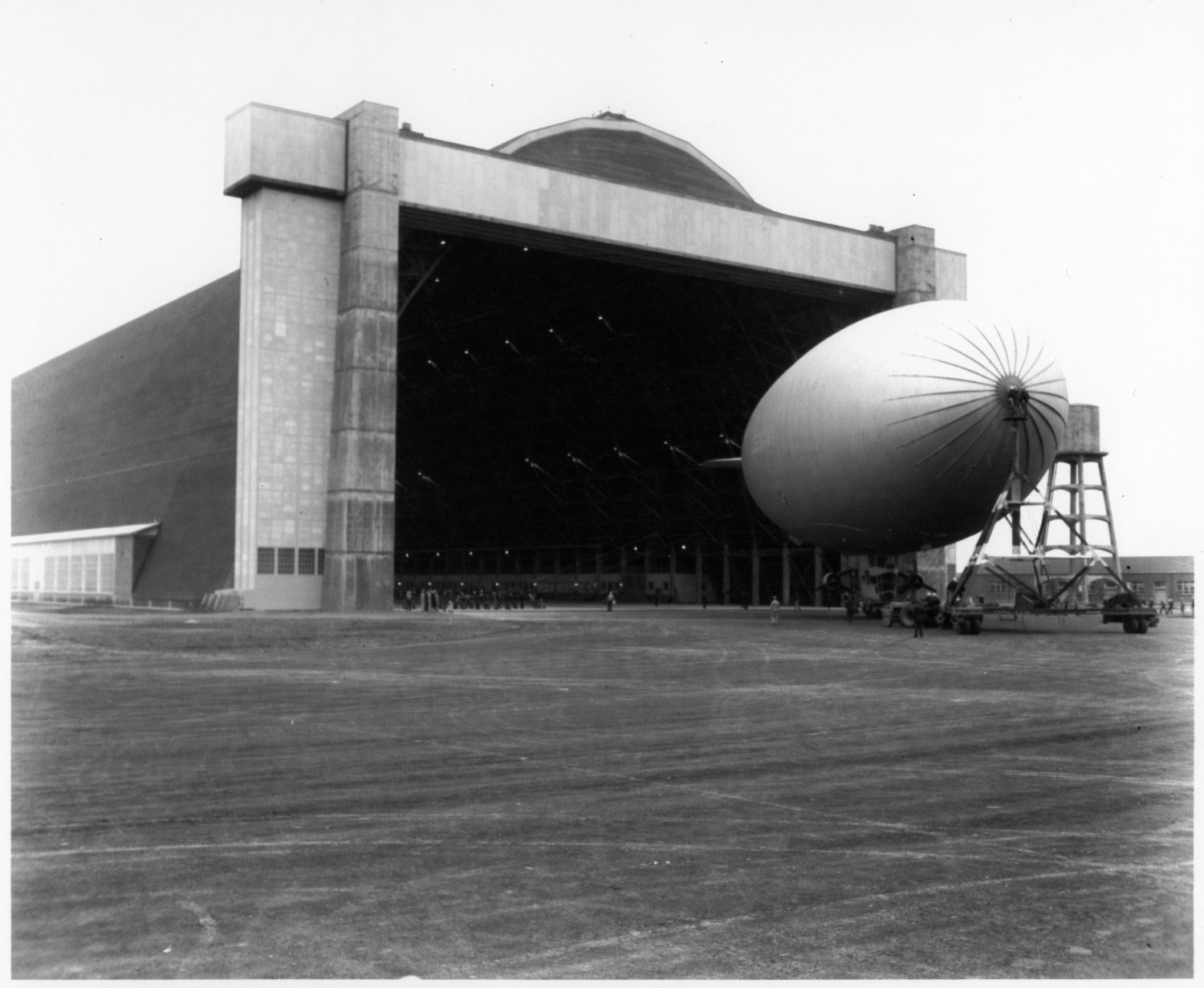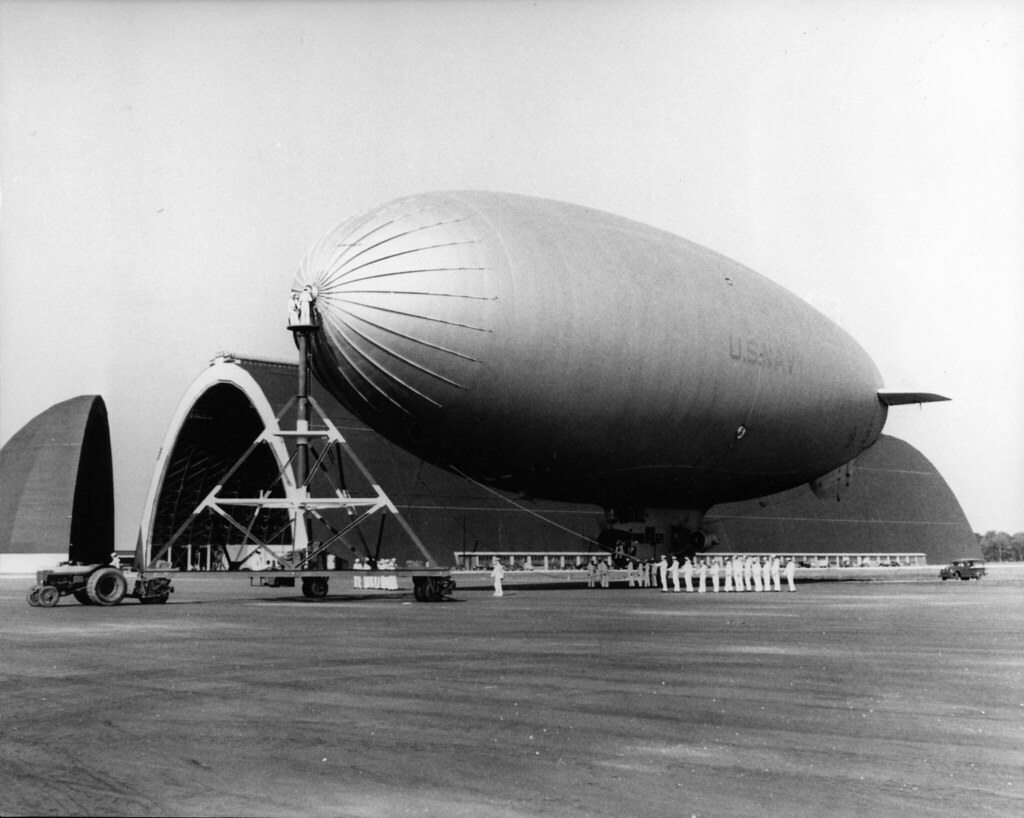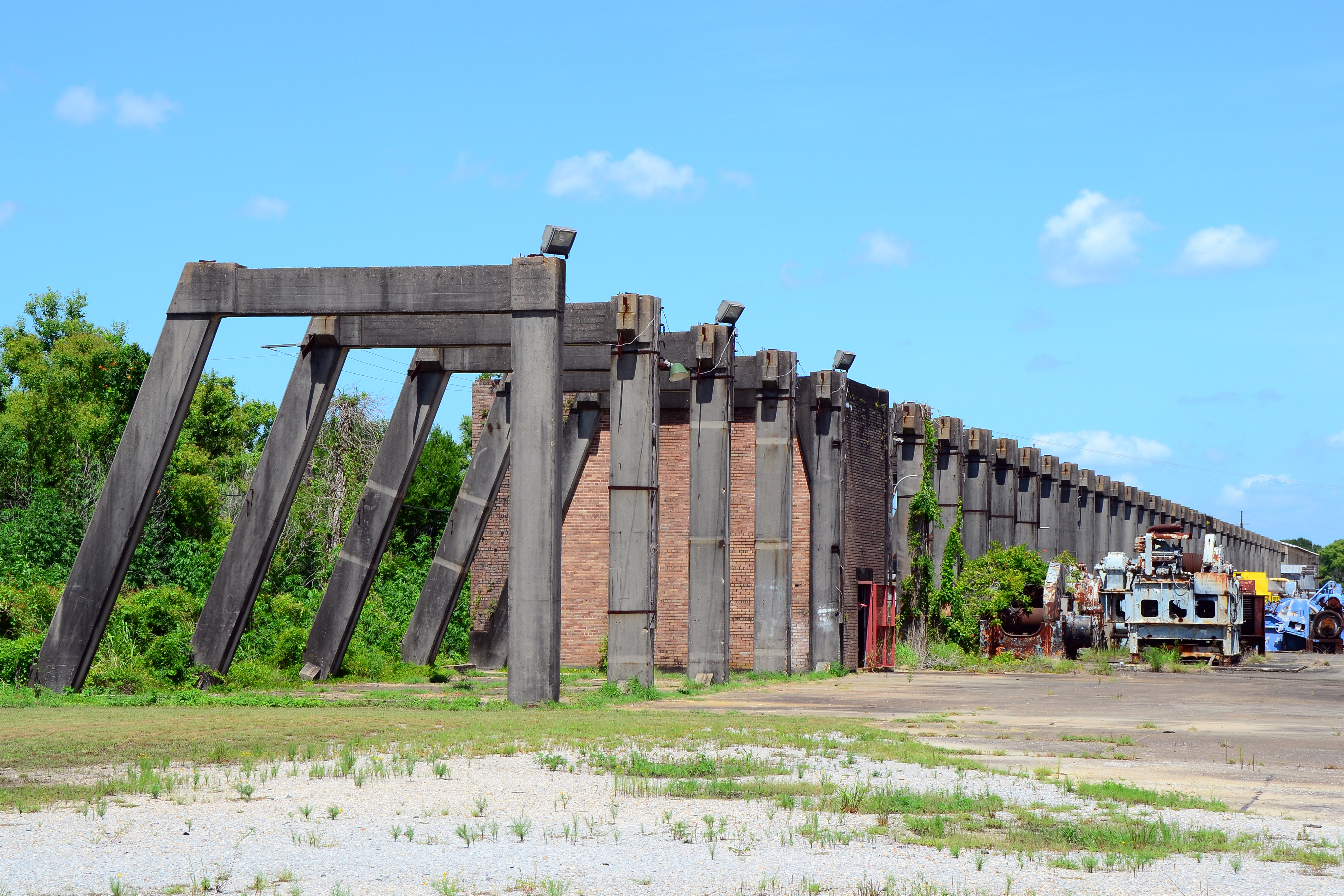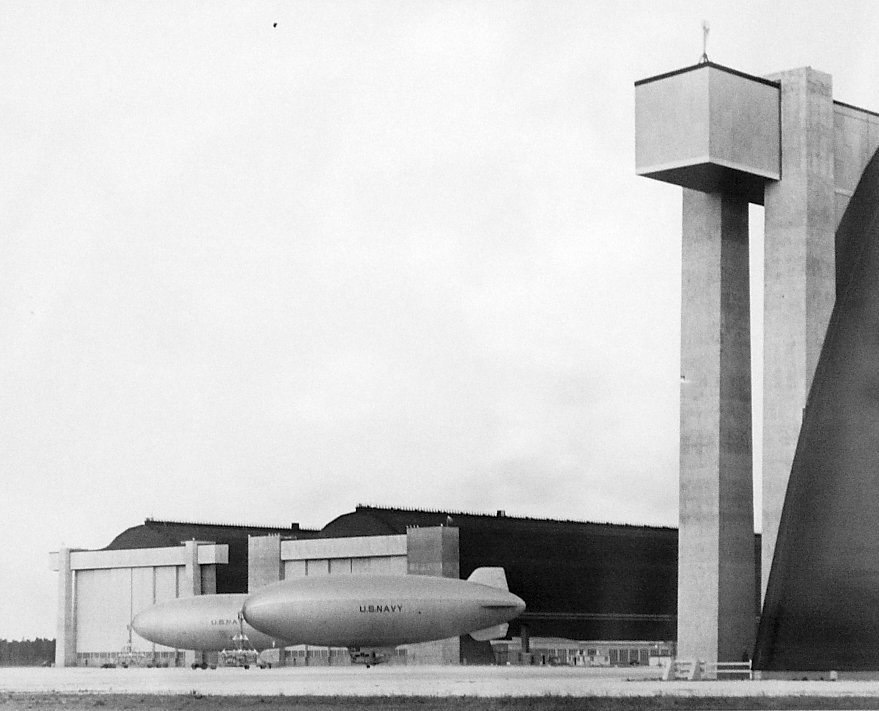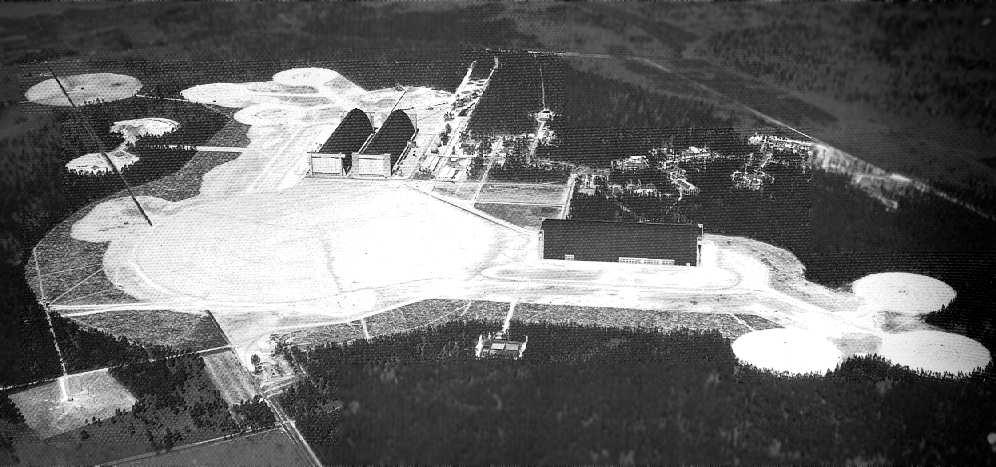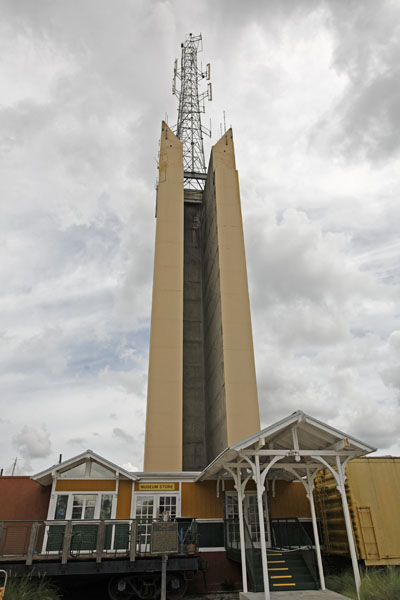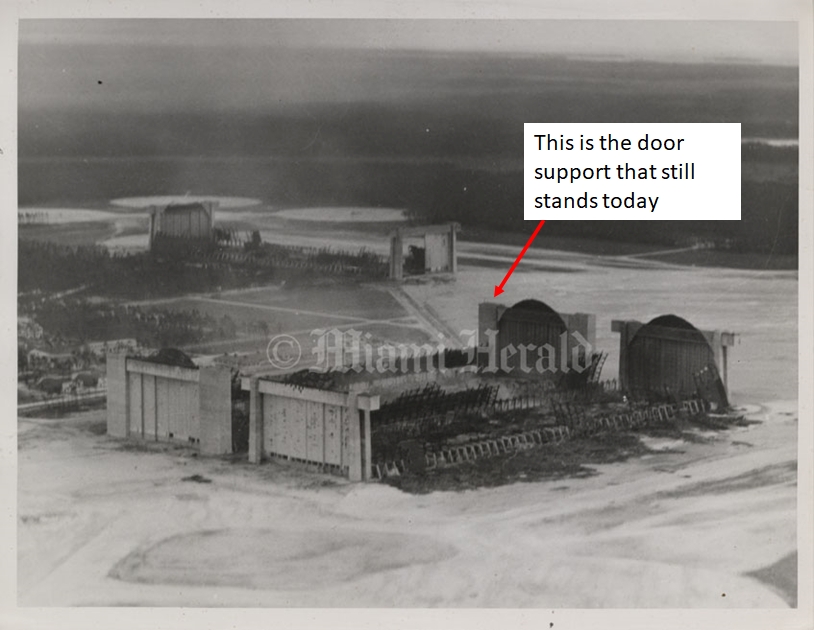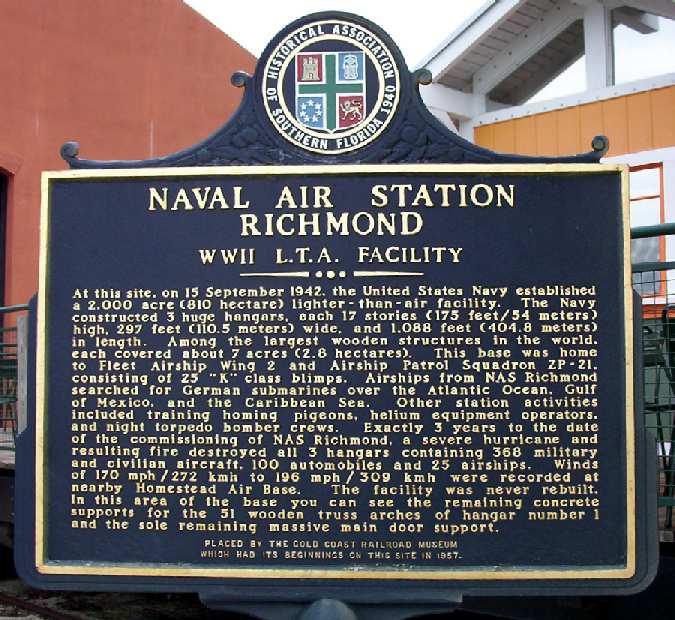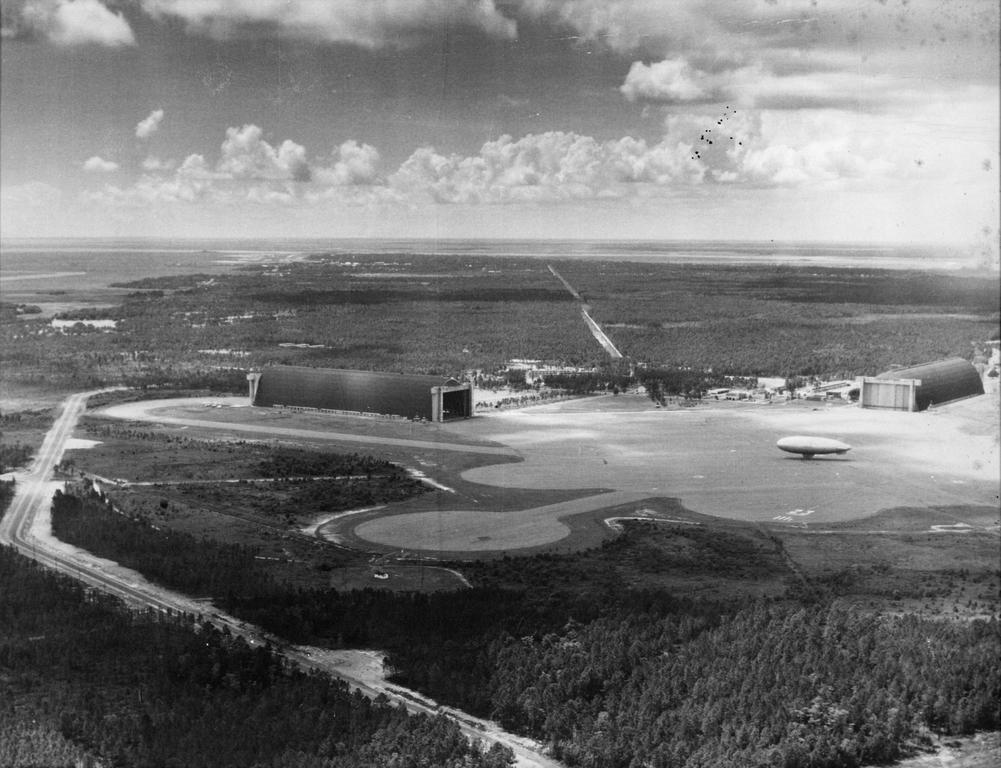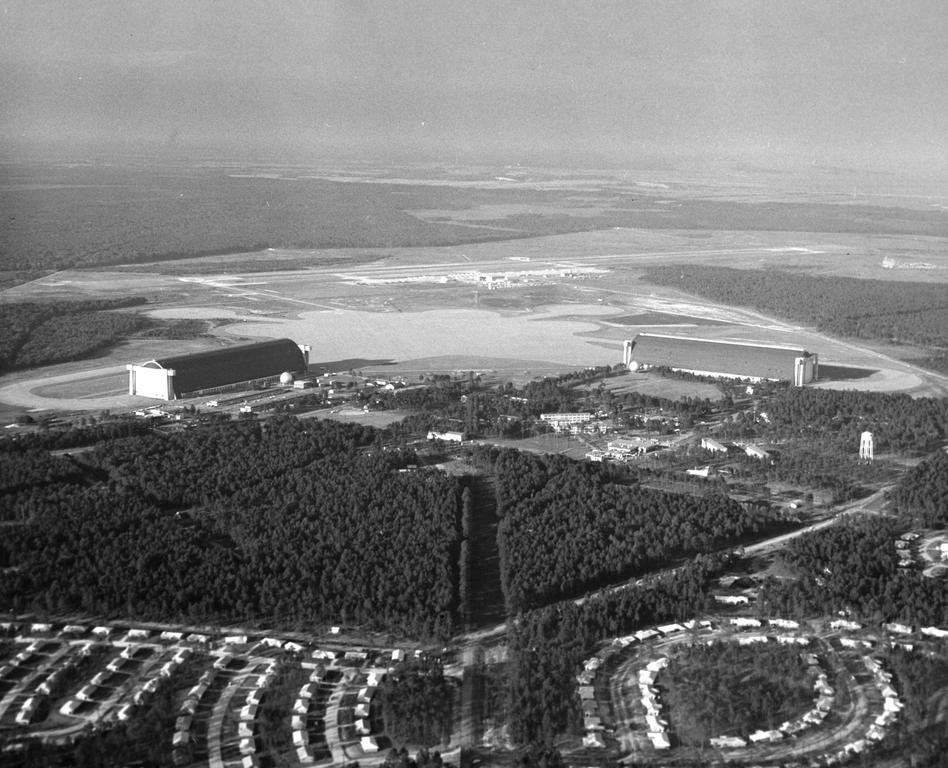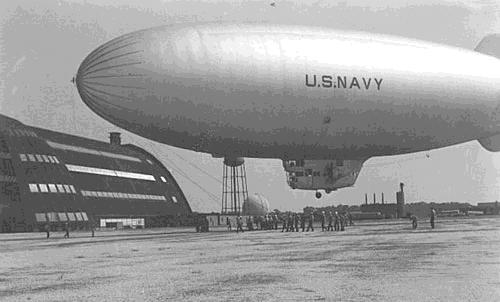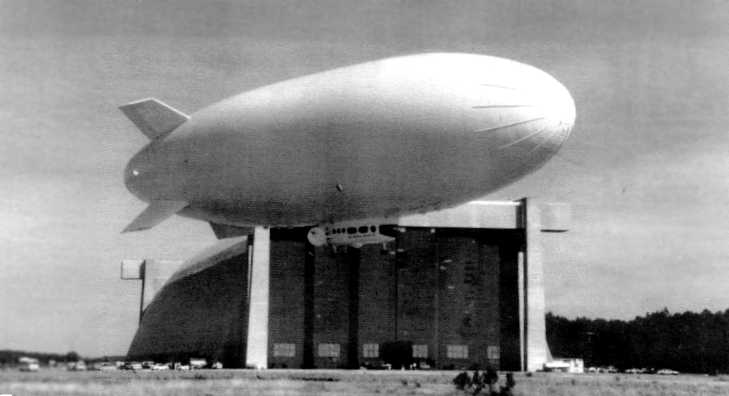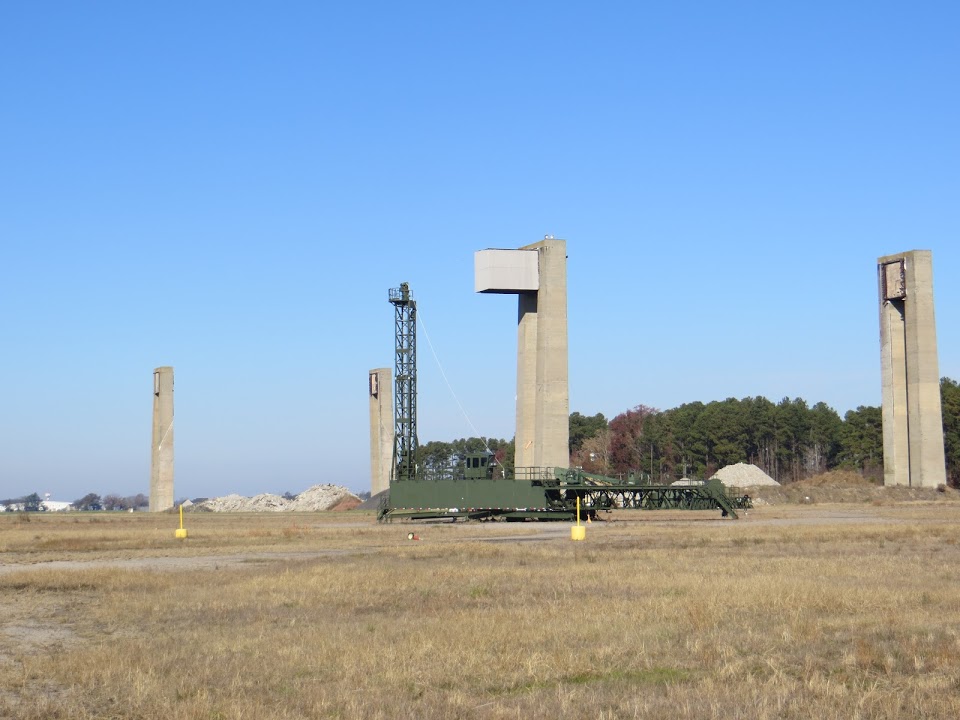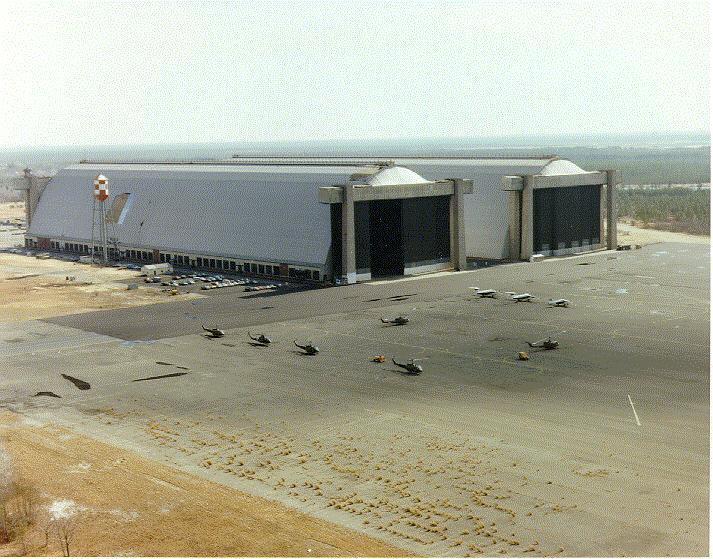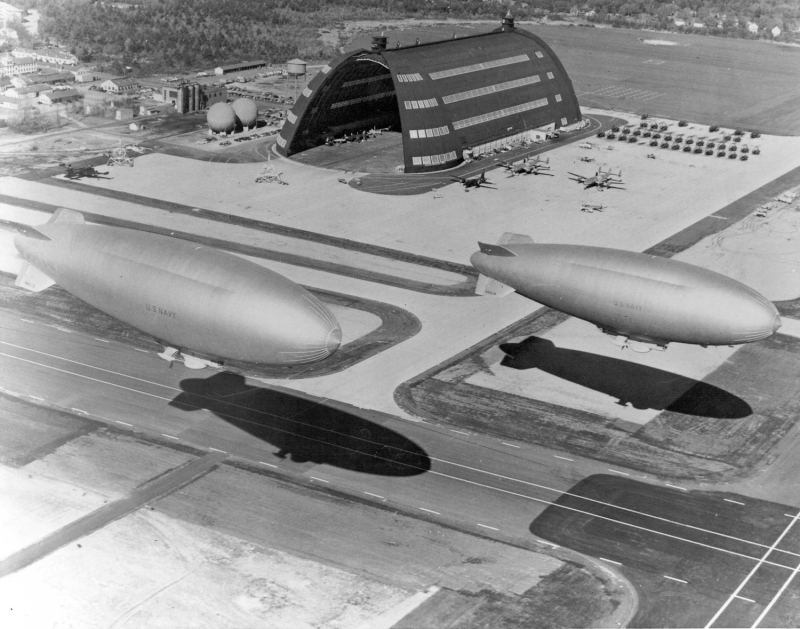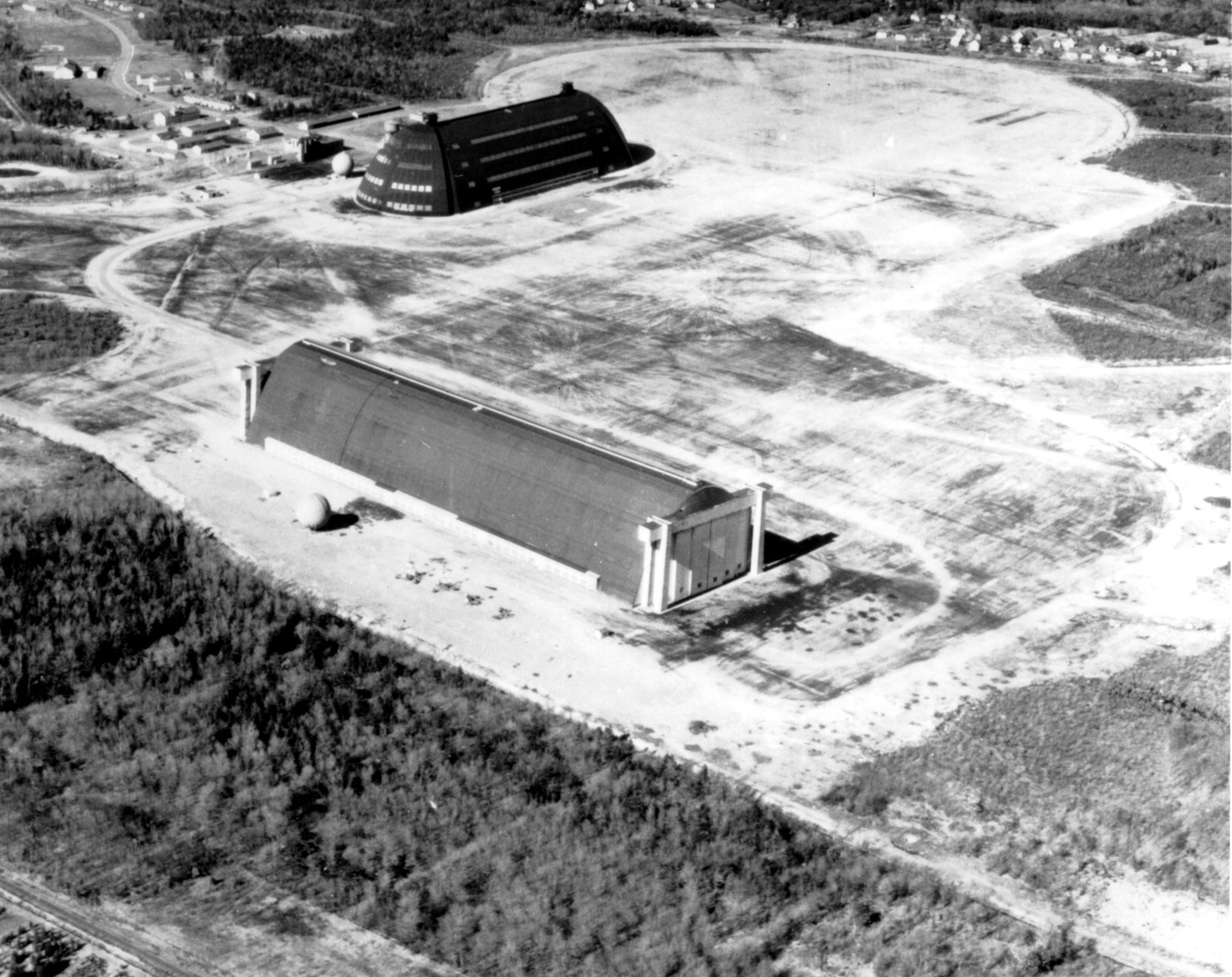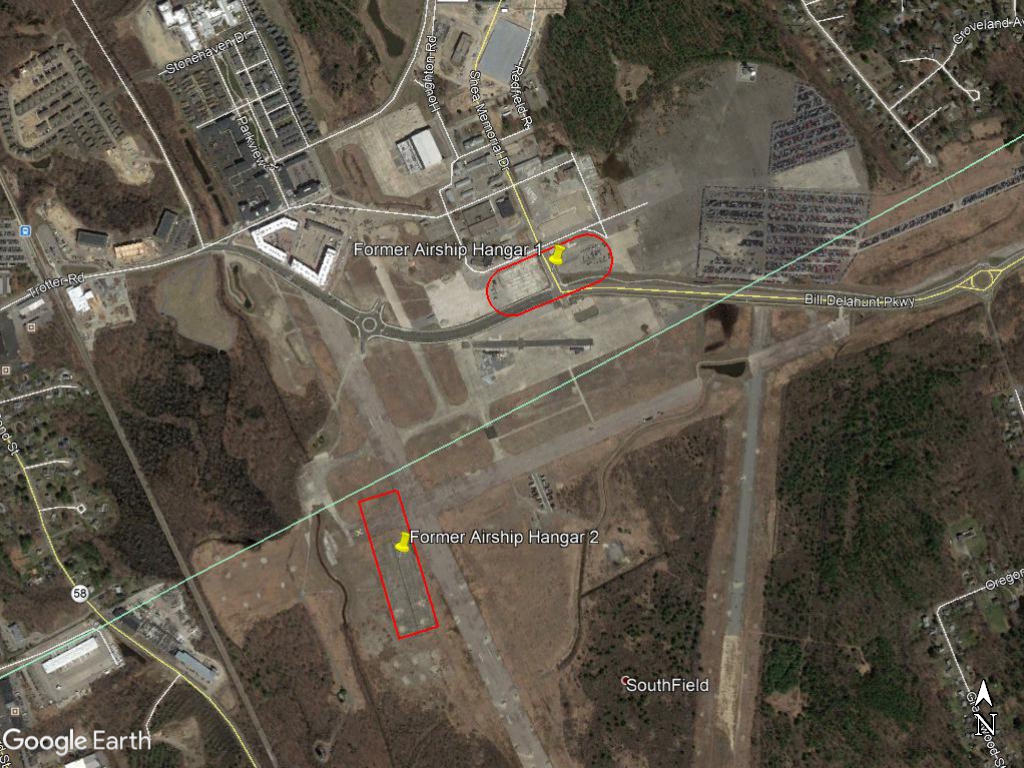US NAS Blimp Bases: Tillamook, Oregon * Sunnyvale, California * Santa Ana, California * Hitchcock, Texas * Houma, Louisiana * Miami, Florida * Glynco, Georgia * Elizabeth City, North Carolina * Lakehurst, New Jersey * So. Weymouth, Massachusetts
NAS Blimp Bases
WW II K-Class Blimp, represents the airships that operated at US NAS Blimp bases during WW II.
Photo credits: Public Domain, National Archives photograph: 80-G-K-13315
During WW II, the US constructed and operated 10 Naval Air Stations (NAS) for Lighter-Than-Air (LTA) operations along the coast of the US as the home of coastal patrol blimps - part of the coastal defense plan during the threat of enemy submarine attacks in the war. These blimps would operate patrols along the US coast waters to look for enemy U-Boats/Submarines. Seventeen wood-framed airship hangars were constructed at these 10 bases to house the Navy's non-rigid airships (mostly K-CLass airships). Today, the old airship bases are long gone, but some of the original hangars still exit, while others have been demolished and only remnants remain. These hangars were some of the largest wooden structures in the world and were wonders to behold. Anyone who can travel to one of the remaining sites where one of these giant hangars still exist are in for a rare treat.
I had not previously discussed, on this site, the locations of these NAS Blimp bases - except for Tillamook, OR, which I had visited. In May, 2020, I received a nice email from reader Neil Strickland who steered me to look for the remnants of the NAS Blimp hangar near Hitchcock, Texas. Intrigued, I complied and found the wonderful remnants of the blimp hangar that once stood at Hitchcock NAS - a site of which I was not previously aware.
When I began investigating the Hitchcock NAS, the hangar location, the blimp activity, and locating photos, it ultimately occurred to me that I needed to look for the remnants of all the NAS Blimp bases of WWII. I found a treasure trove, and it led to this page.
WW II K-Class Blimp base map on display at the Tillamook Museum.
Photo credits: Bill Welker
What's this page about?
This page about the 10 US Naval Air Station Blimp operations during WW II and is a departure from my usual "Then and Now" page where I typically briefly describe the construction details, operation, and demise of a particular airship, and then identify and provide some of the locations I was able to locate where it operated. In this case, the page is not about the particular airship at all. In each case, these bases operated K-Class Navy Blimps for coastal defense. Here, only the places where these blimps operated are highlighted, and the remnants of the great airship sheds identified. Essentially, only the sites are identified, and the rich history of each site is left to the reader. Thus, this page only includes the "Sites of Interest" section - common to all the pages on this site. We begin with Tillamook, Oregon, working in a counterclockwise direction down the West Coast of the US, to the Gulf, and up the East Coast.
Most of these enormous hangars were made of timber, and followed a basic plan: each was approximately 1,086 ft long, 297 ft wide, and 183 ft high and enclosed a floor area of more than 241,000 sq ft. The navy built 17 of the cavernous structures in just two years around the coastline of the US - 1942-43.
Sites of Interest
Tillamook Oregon:
Commissioned in 1942, constructed in 1943 and decommissioned in 1948, it was used primarily to house blimps and had two of the great hangars. The station was the base of operations for LTA Squadron ZP-33, with a complement of 8 K-Class airships.
Aerial view of a US Navy K-class airship of Airship Patrol Squadron ZP-33 at NAS Tillamook, Oregon. Photo credits: Public domain
Both airship hangars survived at Tillamook until 1992, but a fire destroyed Hangar A on August 22, 1992, and today, Hangar B houses Tillamook’s struggling Air Museum. (The hangar is a sight to behold, the only one you can see for the price of a small admission, so see it while you can! Some details are found here: https://welweb.org/ThenandNow/zeppelinstein/us_mus.html#oregon)
2019 photo Hangar B at Tillamook. Photo credits: Bill Welker
The location of the former Tillamook NAS is at (Lat Lon) 45.420596 -123.803406:
.
Location of the former Tillamook NAS. Photo credits: Google Maps.
(This image was posted during the 2020 virus pandemic, so check with the Museum if they are open for visitors: https://www.tillamookair.com/.)
Sunnyvale, California (Moffett AFB)
This former US Naval Air Station is now owned and operated by the NASA Ames Research Center. The base was originally named Airbase Sunnyvale, but was commissioned on 12 April 1933 and dedicated as NAS Sunnyvale. After the death of Rear Admiral William A. Moffett, the airfield at NAS Sunnyvale was renamed NAS Moffett Field on 1 September 1933. (Rear Admiral Moffett died in the crash of the USS Akron off the coast of New Jersey on April 4th, 1933.)
Airship hangars 1, 2, and 3 remain and are designated as a National Historic District listed on the National Register of Historic Places. Hangar 1 (far left in the following photo) was built in 1931 and housed the the USS Macon rigid Naval airship. Hangars 2 & 3 were constructed in 1942-43 when the US Navy established the ten lighter-than-air bases across the United States during World War II as part of the coastal defense plan.
Aerial view of the NAS Blimp hangars at Moffett Field, Sunnyvale, California.
Photo credits: https://historicproperties.arc.nasa.gov/hangar1/gallery_15.html
I could not find a single photo of Blimp operations around Hangars 2 & 3 at Sunnyvale! But here is a photo of Hangar 2 under construction:
View of the NAS Blimp hangar 2 at Moffett Field, Sunnyvale, California.
Photo credits: US Navy photo. Public Domain.
Both airship hangars have survived and are reportedly now "owned" by Google. Google reportedly plans to save Hangar 2, but Hangar 3 is apparently in pretty bad shape and may not be salvageable.
Wooden Hangars 2 & 3, Moffett Field, built in 1942 to house Coastal Patrol Blimps.
Photo credits: https://historicproperties.arc.nasa.gov/hangar1/gallery.html
The location of the former NAS Sunnyvale hangars 2 & 3 is at (Lat Lon) 37.414900 -122.042221. The Moffett Field Historical Society operates a museum next to Hangar 1 but it is unknown if any of the airship hangars can be toured. moffettfieldmuseum.org:
.
Location of the former NAS Sunnyvale Blimp Hangars. Photo Credts: Google Maps.
Return to topSanta Ana, California (Tustin, CA)
NAS Santa Ana was commissioned in October, 1942. Airship operations began with a single blimp operating from a concrete mat and mooring mast until the hangars were completed in the following year. This base was home to Airship Patrol Squadron ZP-31 from Oct 1942 to Sep 1945 flying K-class airships. The site was annexed by the City of Tustin on April 23, 1976, and became Marine Corps Air Station (Helicopter) Tustin on June 1, 1978.
Construction began on Hangar 1, also called Building 28, in October 1942, and was completed in July 1943. Construction on Hangar 2, or Building 29, began in December 1942 and was completed in September 1943. The two hangars are separated by a large circular landing mat that was about 2000 feet in diameter, with five smaller landing mats placed around the hangars in a cloverleaf pattern.
Aerial view of the NAS Blimp hangars at Santa Ana (Tustin), California, 1945.
Photo credits: https://curatingla.com/cla/2012/01/09/historic-tustin-blimp-hangar-closer-to-becoming-centerpiece-of-new-oc-regional-park/
View of a blimp at Tustin in 1943.
Photo credits: US Navy photo. http://www.airfields-freeman.com/CA/Airfields_CA_OrangeCo_SE.htm#tustin.
Both airship hangars have survived the test of time but are under strict control for any use. As of this writing, the hangars have been used in movies and TV commercials, but the south hangar (Hangar 2), located near Warner Avenue and Tustin Ranch Road, is currently undergoing an evaluation to determine future use. It is currently owned by the Department of the Navy and will not be conveyed to the City of Tustin until a determination that environmental remediation on the site is in place and adequately operated by environmental regulators. The north hangar (Hangar 1), located near Valencia Avenue and Armstrong Road, is currently owned by the Department of the Navy. The building sustained roof damage in October 2013 during a windstorm. The Department of the Navy has stabilized the roof, but the building remains closed. (This information was obtained from an undated document from https://www.tustinca.org/765/Tustin-Hangars.) There is a 79 page "The Tustin Hangars: Titans of History" available at https://www.militarymuseum.org/NAS-Santa-Ana-History.pdf
One of the wooden hangars at Tustin, California
Photo credits: https://www.corvetteblogger.com/2019/07/13/pics-the-tustin-blimp-hanger-is-getting-ready-for-the-c8-corvette-reveal/, "Matt in Tustin, CA".
The location of the former Naval Air Station Santa Ana, hangars Buildings 28 & 29 is at (Lat Lon) 33.706296 -117.827478:
.
Location of the former NAS Tustin, CA Hangars. Google Maps.
Return to topNAS Hitchcock, Texas
Construction began in 1942 and the base was commissioned on May 22, 1943. It had a single, giant airship hangar. After WW II, the base was sold as war surplus in 1949. Serious damage was sustained in Hurricane Carla in 1961 and the wooden parts of the hangar were demolished in 1962. It was deemed too expensive to demolish the cement pillars of the giant hangar doors, so the only parts of the hangar still standing are the four, tall concrete corner supports of the two doors and the concrete foundation of each of the now long-gone wooden trusses.
View of a NAS Blimp at Hitchock, Texas.
Photo credits: The Genevieve Miller Hitchcock Public Library Dated November 30, 1943.
Remnants of the NAS Hitchcock Airship Hangar.
Photo credits: Patrick Peters. http://www.eih.uh.edu/documents/history/.
The location of the former Naval Air Station Hitchcok, Texas is at (Lat Lon) 29.332101 -095.043571, south of Hitchcock, Texas. The access road is marked "Private Road No Tresspassing" so permission must be obtained to see the airship hangar remnants:
.
Location of the former NAS Hitchcock, TX Hangars. Google Maps.
Return to topNAS Houma, Louisiana
View of a NAS Blimp Hangar at Houma, Louisiana.
Photo credits: Public domain
The United States Naval Air Station at Houma, Louisiana was a Blimp Base that served anti-submarine warfare patrols in the Gulf of Mexico during World War II. The Air Station was officially commissioned on May 1, 1943. The single large hangar, was over 200 feet high, 1000 feet long and 300 feet wide. During its existence, this hangar was the largest wooden structure in the world. The doors alone weighed 50 tons and moved on rails. Other NAS airship hangars had sliding, sectional doors that were moved on overhead tracks in the hangar's doorframe. Due to the soft, shifting soil of south Louisiana, the hangar doors at NAS Houma were built in a clamshell design that moved on tracks and rolled outward away from the entrances. The hangar could house three fully-inflated K-class dirigibles. Although the hangar was demolished shortly after the war, the concrete foundations of the immense wooden arches are still visible from Clendenning Road on Houma's East Side. The road passes right through the site of the former NAS. LTA Squadron ZP-22 was commissioned into service at NAS Houma on May 15, 1943, and began conducting anti-submarine patrols of the Gulf coast. Operations continued until the unit was decommissioned 16 months later on September 12, 1944.
There had been plans for a second airship hangar, but when the submarine threat greatly reduced as the war progressed, the projected second hangar was canceled. By the beginning of 1945, blimp operations ceased and the station was designated as a Naval Air Facility. The base remained active as an aircraft storage facility until October 1947, when the Navy donated it to the city of Houma. In 1948, maintenance and cost of the blimp hangar were determined to be prohibitive and the hangar was demolished.
View of a NAS Blimp at Houma, Louisiana.
Photo credits: U.S. Navy Photograph, public domain, Date: April 29, 1944
Ruins of the NAS Houma Airship Hangar.
Photo credits: Ian Abbott, Flickr: https://www.flickr.com/photos/ian_e_abbott/29124872531/in/photostream/
The location of the former Naval Air Station Houma, Louisiana is at (Lat Lon) 29.582632, -090.673614, and only the cement foundations for the arched trusses are still visible:
.
Location of the former NAS Houma, LA Hangar. Google Maps.
Return to topNAS Richmond, Miami, Florida
View of the 3 NAS Blimp Hangars at NAS Richmond, Miami, Florida.
Photo credits: Mike Legeros, http://www.airfields-freeman.com/FL/Airfields_FL_Miami_S.htm. US Navy photo, public domain.
NAS Richmond was commissioned in 1942, and was at the time one of the largest construction projects to ever have been undertaken in Dade County. As with all the coastal NAS Airship bases, this one's mission was to protect the coastal waters of southern Florida from enemy submarines during World War II. At its peak, Richmond was home to 25 K-series blimps, a 2,000' diameter landing mat, eight circular concrete mooring pads, 2 runways, the 3 huge blimp hangars, a helium plant, and 3,000 servicemen. The station became the largest blimp base on the east coast.
Aerial view of a NAS Richmond showing the 3 hangars.
Photo credits: U.S. Navy Photograph, public domain
In September, 1945, NAS Richmond was devastated by a direct hit from the "Homestead" hurricane, struck the massive blimp hangars. Many Navy aircraft had been flown to Richmond to be housed inside the hangars to weather the storm. Unfortunately, the hurricane came directly through NAS Richmond. The hangars themselves withstood the fierce winds. But one of the hangars caught fire, thought to have originated from an electrical short circuit. Witnesses reported seeing the winds drive flames horizontal, and eventually all 3 hangars were ablaze, lighting the night sky with burning wood, aircraft, and fuel. It was the largest fire in the United States in 1945.(http://www.airfields-freeman.com/FL/Airfields_FL_Miami_S.htm#richmond)."
When the storm passed, all 3 of the massive hangars were completely detroyed, and only smaller buildings & the hangars' concrete door pillars remained. The war was over, so the massive hangars would not be rebuilt.
Today, the site of NAS Richmond is part of the "Gold Coast Railroad Museum". Of all three hangars, only part of one hangar still exists. One of the massive cement columns which supported the hangar doors still stands, and some of the massive cement foundations of the same hangar are to be found next to the railroad displays.
Ruins of one of the great hangars at NAS Richmond.
Photo credits: Joe May,
https://travelforaircraft.wordpress.com/2010/03/26/photo-funday-%E2%80%94-hangar-door-hanger/
Here is a photo to help visualize the single cement door frame pillar with still exists:
Photo showing the single remaining hangar-door pilar at NAS Richmond.
Photo credits: Miami Herald photo, edited.
The location of the former Naval Air Station Richmond, Miami, FL is at (Lat Lon) 25.616869 -080.400133, and assuming it's worth admission to the train museum, one could still look at this great, nearly lost airship history.
.
Location of the former NAS Richmond, Miami, Florida. Google Maps.
If one visits the Gold Coast Railroad Museum, they will be greeted by a nice historical marker which highlights the activity which once took place at the site.
Historical marker about the former NAS Blimp site at the Gold Coast Railroad Museum
Photo credits: http://www.airfields-freeman.com/FL/Airfields_FL_Miami_S.htm
NAS Glynco, Brunswick,Georgia
View of the 2 NAS Blimp Hangars at NAS Glynco, Brunswick, Georgia.
Photo credits: Public domain, from https://www.flygcairports.com/historic-photo-gallery.html.
NAS Glynco was the home for LTA Patrol Squadron 15 (ZP-15), a subordinate unit of Fleet Airship Wing One at Lakehurst, New Jersey. Naval Air Station Glynco, located north of Brunswick Georgia, was commissioned January 25th, 1943 as one of five airship bases strategically located between Massachusetts and Florida. The two massive hangars survived until 1971 when they were both demolished to make way for development. The site of the former Naval Air Station is now the location of both the Brunswick Golden Isles Airport and the headquarters of the Federal Law Enforcement Training Center.
Aerial view of a NAS Glynco showing 2 hangars.
Photo credits: U.S. Navy Photograph, public domain
There is a great website dedicated to the NAS Glyco here: Brunwsick Golden Isles Airport which will have to do for any history of NAS Glynco for nothing of the airship hangars remain. There is also a very nice history of NAS Glynco found here: Project Glynco.
Thus I leave you with an overlay of an aerial of the former NAS base on top of today's development. Slider the slider back and forth to see the location of the former NAS:
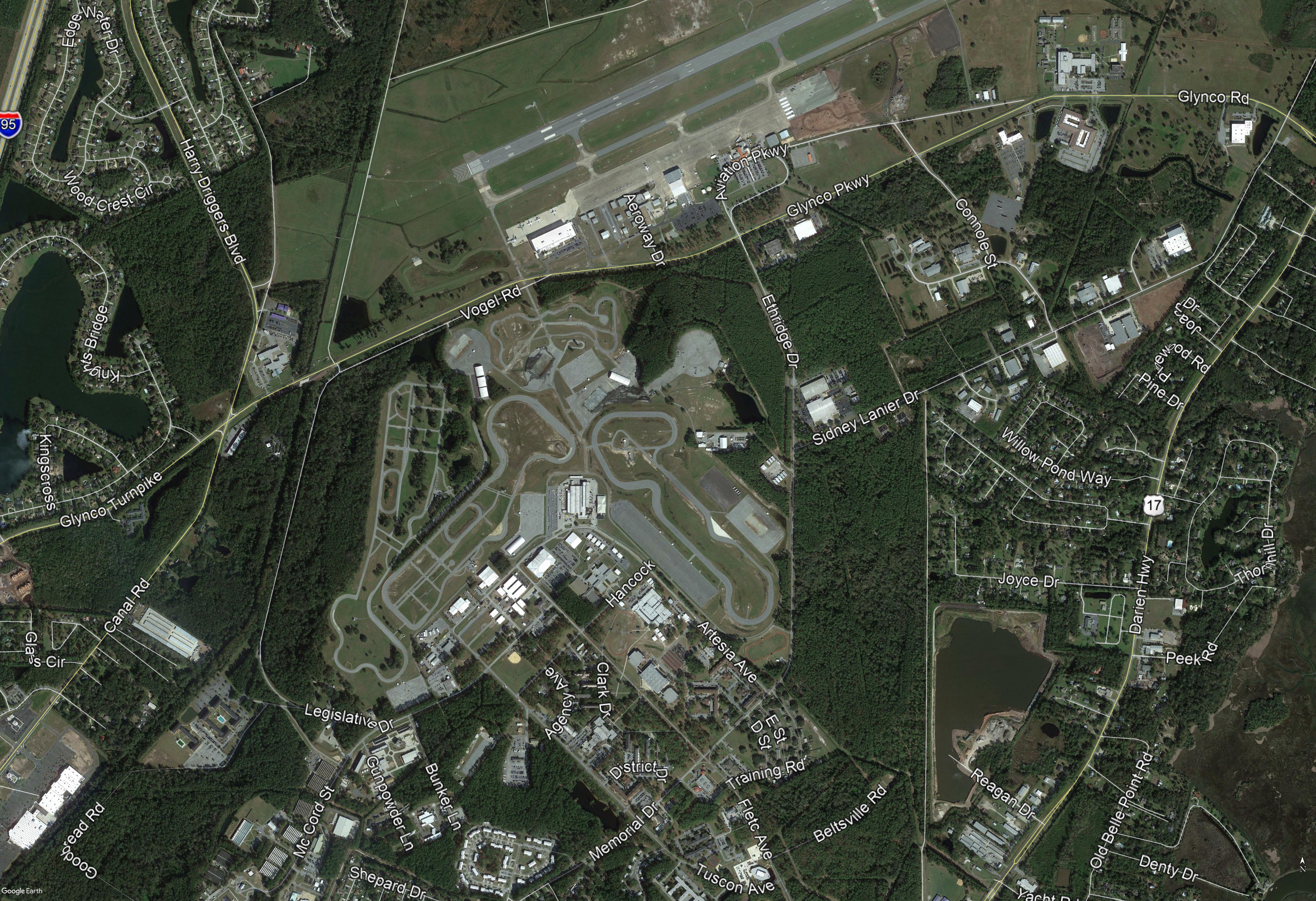
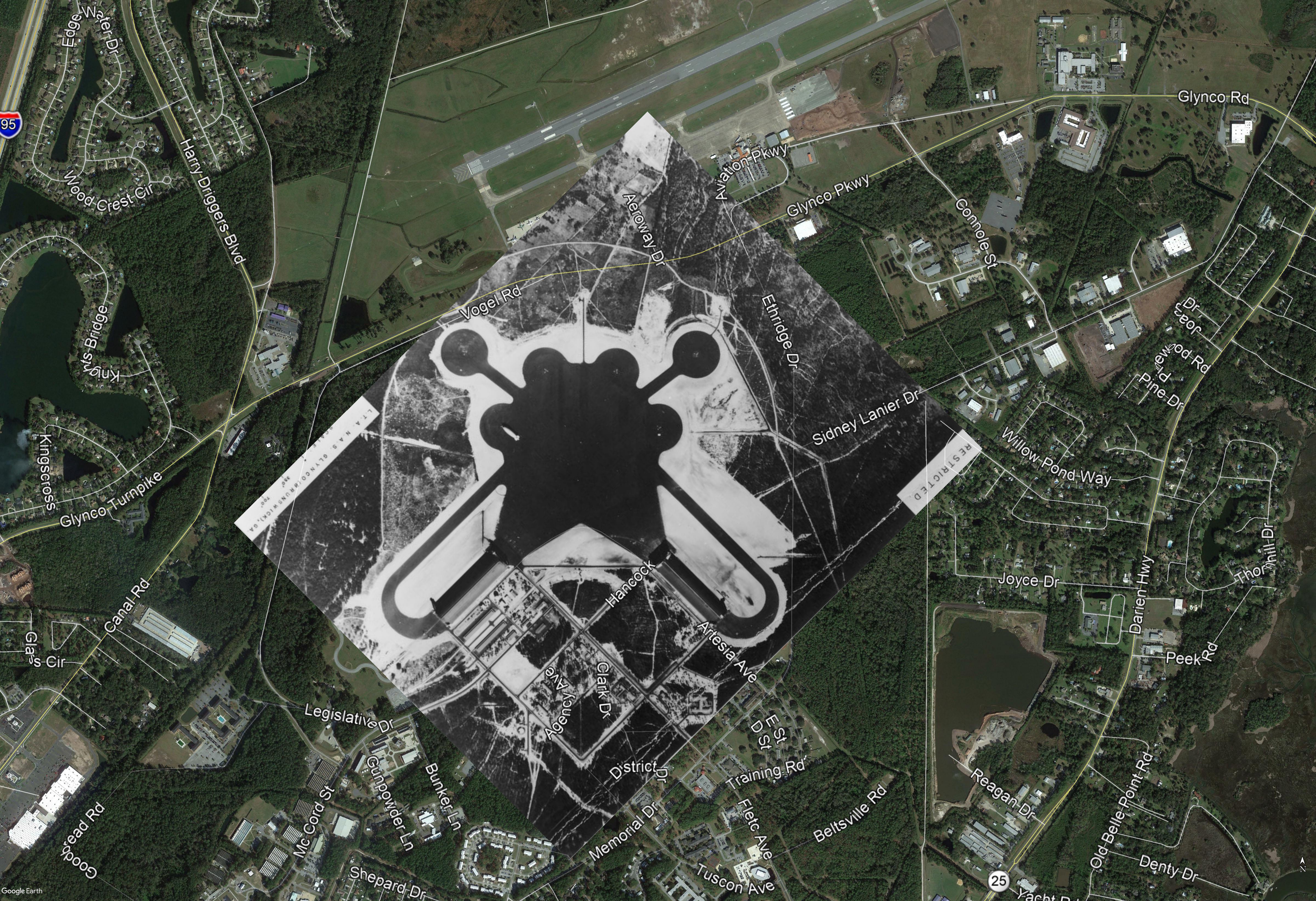
The location of the former Naval Air Station Glynco is at (Lat Lon) 31.244294 -081.474146, and there is apparently not one remnant of the hangars remaining.
.
Location of the former NAS Glynco, Brunswick, Georgia. Photo credits: Google Maps.
Compare the map above with this next image which has the former hangar locations marked:
Aerial view of a NAS Glynco with the 2 hangar locations marked.
Photo credits: Google Earth
NAS Weeksville, Elizabeth City, North Carolina
View of a NAS Blimp operations at Weeksville, Elizabeth City, North Carolina.
Photo credits: Public domain
Blimp base NAS Weeksville was constructed in 1941, second only in the construction program to Lakehurst NAS. NAS Weeksville was commissioned in 1942 and squadron ZP-14 began operations with 8 K-Class Blimps in coastal operations to find enemy submarines.
There were two hangars, a large, central mooring pad and 5 smaller blimp mooring pads. Hangar No. 2 was the classic wooden design common to most of these NAS blimp bases, and Hangar No. 1 which was constructed of steel. Each hangar could hold 6, fully inflated blimps. Today, only Hangar No. 1 remains and only remnants of Hanger No. 2.
At the end of WW II, the base was recommissioned as a Naval Auxiliary Air Station in late 1945. The last Navy blimp was decommissioned in 1946, and the facility was used for aircraft storage until 1948. The site was re-used as a blimp base again, briefly, during the Korean conflict. The site was eventually decommissioned in 1957 and sold to commercial owners.
The wooden Hangar No. 2 survived until August, 1995 when a fire during reconstruction efforts on the hangar doors consumed the structure. The fire destroyed three Airship Industries (now Airship Management Services) "Skyship" blimps then under development.
The Skyship Sentinal 1000 being tested at Weeksville in 1994 or 1995 before the hangar burned.
Photo credits: http://www.airfields-freeman.com/NC/Airfields_NC_NE.htm#weeksville
Ruins of the NAS Weeksville Airship Hangar No. 2.
Photo credits: Mett Ausley, https://lh5.googleusercontent.com/p/AF1QipNu24rNevGXvNq_qVRAEcbYcRreo1Z9KSHvsdBC=h720
The location of the former Naval Air Station Weeksville is at (Lat Lon) 36.234804 -076.137082, and only the cement columns of the giant door supports of Hangar 2 remain while Hangar No. 1 remains and is still used today:
.
Location of the former NAS Weeksville Hangar. Google Maps.
Return to topNAS Lakehurst, New Jersey
NAS Lakehurst, New Jersey is, of course, the most famous Airship facility in the United States for it is where the great rigid airships operated. US rigids and German Zeppelins were common at Lakehurst through the 1920s to 1930s. And Lakehurst is the site of the horrible Hindenburg disaster in 1937. That disaster brought the age of the great airships to an end.
Lakehurst was also one of the ten sites for coastal patrol during WW II. Hangars 5 and 6 were built adjacent to one another and were completed in 1943. They were constructed using the same wood-skeleton design and specifications or the other fifteen or so blimp hangars erected at NAS blimp bases of the era that were established quickly to defend naval and shipping fleets during WW II. At the onset of WW II NAS Lakehurst was the only operation base in the US and in December, 1941, the Navy had only 6 sea-going, patrol airships.
LTA Squadron ZP-12 operated at Lakehurst and is one of only 2 LTA squadrons to remain active after WW II. (The other LTA squadron continuing to operate after the was was ZP-31 and NAS Santa Ana, Moffett Field). After the war ZP-12 was re-designated LTA Squadron ZP-2 and ZP-31 became ZP-1. LTA Squadron ZP-2 remained active until it was decommissioned in November, 1959.
Undated view of coastal patrol hangars 5 & 6 at NAS Lakehurst.
Photo credits: Public domain
While the coastal patrol hangars still stand at Lakehurst, they are no longer used for any Navy airship operations but are still used occasionally for commercial blimp ventures or storage facilities. In addition, NAS Lakehurst is now part of Joint Base McGuire-Dix-Lakehurst, and active military facility, so these hangars are essentially off-limits to the public.
The location of these blimp hangars at the former Naval Air Station Lakehurst is (Lat Lon) 40.027935 -074.337065:
.
Location of the former NAS Lakehurst Hangars 5 & 6. Google Maps.
Return to topNAS Weymouth, South Weymouth, Massachusetts
Naval Air Station South Weymouth, Massachusetts served as a United States Navy air base from 1942 all the way up to 1997. NAS South Weymouth was originally built and commissioned to support regular Navy blimp coastal patrol operations during WW II and is the last of our "tour" of the blimp bases, discovering the remnants.
1954 view of NAS Waymouth after it was re-opened as part of the Naval Air Development Unit's (NADU) large fleet of research aircraft.
The hangar in the photo was ultimately demolished in 1966.
Photo credits: Public domain
As built during WW II, the base had two blimp hangars, one made of steel (Hangar 1) and the other made of wood (Hangar 2). The wartime base also had a 2,000 foot diameter blimp landing mat, six mooring circles, and a 4,500 foot long grass runway.
Undated view of NAS Waymouth showing the two blimp hangars.
Photo credits: Public domain, from http://www.airfields-freeman.com/MA/Airfields_MA_Boston_SE.htm#weymouth
Hangar 1, as already mentioned, survived to 1966. Hangar 2 was demolished in 1953 (unverified) during at site reconstruction for a Naval Reserve program.
The location of these blimp hangars at the former Naval Air Station So. Weymouth is (Lat Lon) 42.151881 -070.942295:
.
Location of the former NAS So. Weymouth. Google Maps.
In case you have some difficulty visualizing where the two hangars were located, here is an overhead image with the outlines drawn-in:
View of the location of NAS So Weymouth with the two blimp hangar locations marked.
Photo credits: Google Earth.
All that remains of both hangars are some ground-level foundation remnants - the cement flooring pads and, in the case of Hangar 1, the semi-circular railroad rails which once carried the massive clamshell doors, and the remnants of the 2000' diameter blimp landing pad apparently used now as a parking lot for automobiles. It is unknown if this site is accessible to the public should someone wish to stand in the place of this nearly lost history.
Return to topEndnote:
I hope you enjoyed this page which identifies the locations of all 10 of the US, WW II Naval Air Station Coastal Defense sites. Many of the sites today still have remnants of this brief US history visible, while one (NAS Glynco) has nothing left whatsoever. Wouldn't it be nice if each of these sites had a monument or at least a roadside marker to reveal to people the valued, but nearly lost history (as is found at the former NAS Richmond, Miami site)?
Return to top
